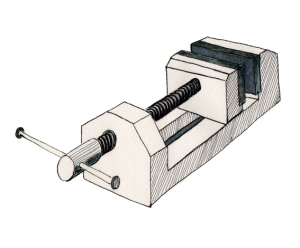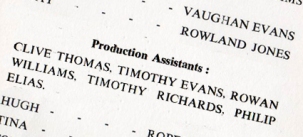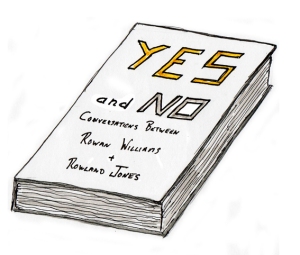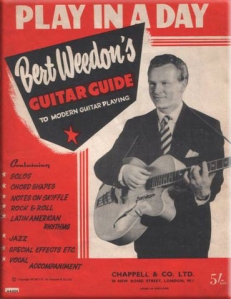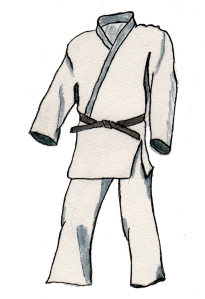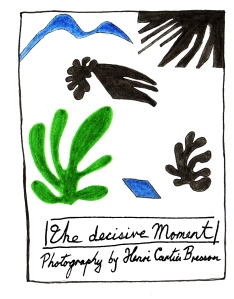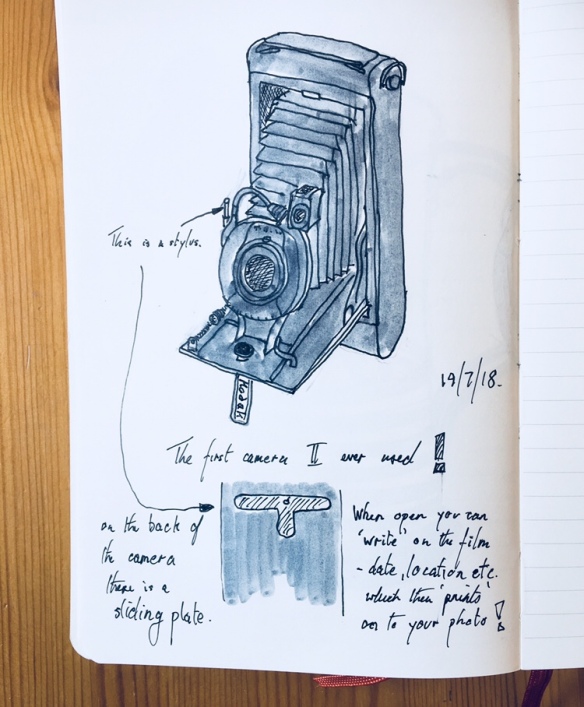
1970 – Engineering?
RJ heads off to Manchester University to study engineering . . . .
Though mechanically minded, RJ finds the theory tedious. He leaves
university to live in Hebden Bridge, where he finds work, by following
in his grandfather’s footsteps, and becomes a blacksmith.
His enquiring mind draws RJ to more inventive work and he plans a series of working designs inspired by the work of Heath Robinson, such as this mobile phone with
shoulder stand and ‘hands-free option top hat’
Totally immersed in this project, his business takes secondplace to
his vision, and he finally establishes a sculpture park based on three
dimensional representations of the designs of his hero, such as The Moth Trap.
1990-Djazz
Jazz finally ’clicks’ for RJ and inevitably, he becomes obsessed; listening to jazz 24 hours a day buying CDs by the dozen, and attending workshops.
RJ, now fanatical about Reinhardt, sells his house, car, and ten of his eleven guitars. With his ‘Maccaferri’ guitar, and a VW, RJ heads to Samois-sur-Seine, his hero’s last resting place.
Finding work as a waiter, he is able to make ends meet but in order to conserve his resources he lives in the VW, adopting his version of a gypsy lifestyle. After a long evening playing at a festival, RJ falls asleep whilst having a last cigarette, which sets fire to the caravan . In a bizarre parody of the incident which befell his hero, RJ receives first-degree burns which leave him unable to play the guitar.
Taking this as a sign that he is playing the devil’s music, RJ founds, and spends the remainder of his life working for SATAN, Society Against The Apocalyptic Noise, though due to a slightly dyslexic mason his headstone wrongly states that he did much good work for SANTA.
1966 – Holmes
RJ discovers Sherlock Holmes – the detective’s deductive powers and immutable logic appeal to his somewhat obsessive nature
RJ enters the police force, working during the day and studying at night
with an almost monastic dedication, though, like his fictional hero, he is
fuelled by various stimulants. RJ becomes the youngest-ever Head of the Serious Crime Squad.
Frustrated by bureaucracy, RJ drifts towards the ‘dark side’. Inspired by the likes of Count Victor Lustig, George C. Parker, and Eduardo de Valfierno, he begins a life of ‘victimless crime’ targeting known, but ‘untouchable’, criminals.

RJ discovers Sherlock Holmes – the detective’s deductive powers and immutable logic appeal to his somewhat obsessive nature
RJ enters the police force, working during the day and studying at night
with an almost monastic dedication, though, like his fictional hero, he is
fuelled by various stimulants. RJ becomes the youngest-ever Head of the Serious Crime Squad.
Frustrated by bureaucracy, RJ drifts towards the ‘dark side’. Inspired by the likes of Count Victor Lustig, George C. Parker, and Eduardo de Valfierno, he begins a life of ‘victimless crime’ targeting known, but ‘untouchable’, criminals.
Having amassed a substantial fortune, RJ decides on one final ‘mark’ before retiring. His confidence overwhelms his judgement, and he cons a Russian billionaire, selling him share options in a proposed United-City Manchester football team. . . .
Shortly afterwards his home in Sicily is razed to the ground whilst RJ sleeps.
1965 – A man of the cloth
RJ appears in a school production of the Benjamin Britten work, ‘The Little Sweep’. One of the production assistants is Rowan Williams.
RJ and Rowan Williams become close friends though arguing ferociously over theological issues at school and throughout their lives, in lengthy and erudite letters. They each follow their own paths: Williams eventually becoming Archbishop of Canterbury.
RJ becomes a priest and moves to Ruanda, though he and Williams remain in contact by their increasingly lengthy letters, which are later published under the title ‘Yes and No’.
Exactly 67 years after first meeting Williams, RJ becomes the first Welsh pope. Unfortunately, his decision to take his great-grandfather’s name in a gesture of religious solidarity is not well received and after a series of bomb threats, Pope Moses 1 is forced to resign and he returns to Wales.
75 years later he is canonised: St Moses – the Patron Saint of Good Intentions
1967 – CSNJ
One Sunday evening, RJ is introduced to the guitar by his cousin, John, and learns to play 8 chords. RJ is hooked.
Having fulfilled his filial duty by completing school, RJ heads for Manchester where he finds a band who are appreciative of his guitar playing and harmony vocals.

One Sunday evening, RJ is introduced to the guitar by his cousin, John, and learns to play 8 chords. RJ is hooked.
Having fulfilled his filial duty by completing school, RJ heads for Manchester where he finds a band who are appreciative of his guitar playing and harmony vocals.
The band split due to musical differences, and RJ and one other member of the band leave for the U.S.,where they form the super group Crosby, Stills, Nash and Jones, who make their debut at Woodstock and go on to record several classic albums.
A victim to the hedonism of a rock’n’roll life-style, RJ abuses his body in every possible way until he finally collapses. After this traumatic experience, he leaves the world that made him both rich and famous and moves to a smallholding in Patagonia where he writes poetry in Welsh and restores antique fountain pens.
1964 – Tom
RJ records ‘How beautiful are the feet’ from Handel’s Messiah for ‘Wil Six’ a BBC radio play. He is paid nearly six guineas.
Attracted by the prospect of money and fame, RJ saves enough money to buy a tape recorder. After many late nights listening to Radio Luxembourg, he meticulously re-records US classic songs which he sends to Tom Jones.
Seeing a commercial opportunity with a younger namesake, the older Tom invites the younger Tom (Rowland) Jones to record the jointly penned ‘Two is better than one’. Following an appearance at The Royal Variety Show the single is a huge, but sadly their only, success.
Finally with his dreams shattered and his money spent, RJ returns to his hometown, where he finds work as a cobbler. For a short while, his meagre wages are supplemented by royalties when a foot cream manufacturer uses his original BBC recording for a T.V. commercial.
1960 – DoJones
On a Sunday School outing to the Welsh seaside town of Porthcawl, RJ is ‘roughed up’ by a couple of older boys.
Determined that he will never be physically threatened ever again, RJ joins a judo club run by British Olympic Gold Medallist Alan Petherbridge. Inspired by his mentor, at the age of eighteen, RJ travels to the Far East where he studies Martial Arts for ten years.
RJ returns to Wales where he establishes a chain of clubs called DoJones. Five years later, witnessing a young boy being terrorised by a group of older boys, RJ intervenes. He hospitalises the thugs. Unfortunately all seventeen of them take out Civil Actions, and he is given a suspended sentence for GBH.
Distraught that he has broken the code of honour, RJ returns to the Far East and joins the ascetic Kodo community on the island of Sado where he spends the rest of his life studying the Taiko.
1959 – negative attitude . . . . .
RJ is given a KODAK 44A for his eighth birthday.
Whilst on a family holiday in Eastbourne, the young RJ meets Henri Cartier-Bresson who is staying at the same hotel. Impressed by his enthusiasm and natural talent, Cartier-Bresson allows RJ to assist him.
Seven years later on a school trip to Paris, RJ searches out his hero. He remains in Paris and after working with the likes of Willy Ronis and Robert Capa, he becomes the youngest-ever member of the Magnum Photo Agency.
Incensed by the war and inspired by the work of Capa, RJ goes to Vietnam. Desperate to influence public opinion, he begins to fake increasingly horrific images, finally faking his own death. When his battered Nikon F is found, it contains thirty six shots which become ‘iconic’ images of the conflict.
The world of photojournalism mourns.
Still in hiding, RJ is killed when the field kitchen in which he is working explodes.
RJ is disgraced and is posthumously expelled from Magnum.


